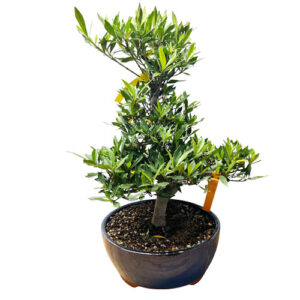The Gardenia Bonsai Tree (gardenia jasminoides) is popular for the strongly scented white flowers it produces. Gardenias are evergreen and best kept indoors
Gardenia (Gardenia jasminoides)
Despite being a challenging species to look after, the gardenia is very well-loved for its heavily scented cream coloured flowers in spring. It is an evergreen, tropical species that is native to regions of Asia and south Africa.
Placement
The Gardenia bonsai tree is an indoor bonsai and can only be kept outside in tropical climates. They require an airy, humid atmosphere with warmth and light but not strong or direct sunlight.
It thrives in warm climates around 20 °C – 23 °C, so place it where this sort of temperature is more or less constant throughout the year but avoid placing next to central heating sources such as radiators as this will dry out the root ball. It can survive outside in the summer if the nights are warm enough (they do not tolerate drops below 15 °C). The Gardenia bonsai tree is a little trickier in the winter when days are shorter and colder, so consider supplementing with artificial grow lights and horticultural heaters to provide adequate energy for healthy growth. Note that during the winter, temperatures down to 7 °C would be acceptable while the tree is dormant.
Watering
There is no definitive guide to watering and it should be conducted on an observational schedule, not a routine. This means that it is important to keep an eye on the moisture levels of the soil to avoid over and under watering, both which can lead to dropping leaves and/or root death. The amount of water a bonsai requires depends on pot size, climate, airflow, soil and tree type so it is best to use your eyes and fingers to assess whether the soil is damp, wet or dry.
If the top inch or so of soil has dried, it is ready to be watered. When you water, ensure an even coverage over the roots and soil, allowing water to flow out from the bottom of the pot to ensure a good soaking. If you are a first-time bonsai owner, another good way to water is by submerging the entire pot in water until the bubbles stop. If you choose this method, be aware that your bonsai may not need watering for another two or three days, but this will depend on the factors mentioned above.
Note that if you live in a hard water area, it would be better to use rainwater on your Gardenia bonsai tree, which prefers a more acidic PH.
Fertilising
Using fertiliser on your Gardenia bonsai tree will help encourage healthy growth and this should be done periodically from once a week to every two months and only during the growing season. You can start adding Chrystal Liquid Bonsai Feed to your water from March until October and use weekly. Use Naruko Fertiliser Slow Release Bonsai Feed once every one to two months. With bonsai trees, less is more, and we tend to advise using half the recommended dosage to see how your bonsai reacts first.
Pruning and wiring
Pruning your bonsai is important not only to maintain or create an aesthetic style but to also ensure light and airflow can reach inner leaves and the Gardenia bonsai tree tolerates pruning well. As soon as the flowers have wilted and died, pinch or cut them off (around late summer). Remove the whole flower, including the dead petals and the whole bud from which it came. In this time period, begin pruning the branches and leaves too, since the buds for next year’s flowers will start forming. If left too late into the year you could risk losing them during the pruning process. Pinching out new growth would encourage the Gardenia bonsai tree to grow bushier and ramify better and this should also be done after flowering.
Training your Gardenia bonsai tree using wiring should be conducted in May and June, when the branches are most pliable. We recommend using wires with a thickness that matches the thickness of the branch: If the wire you choose is too thick you will damage the bark. If it is too thin, it won’t be effective.
Repotting
Repotting your tree is an important way to provide a fresh and suitable soil mix and ensure appropriate root health. Repot in early spring. Generally, your Gardenia bonsai tree will need to be re-potted once every two years if it is young, while older ones can stay in their pots for longer. However, you should always check if it has become root-bound before you change pots. You can do this by lifting the tree gently out of the pot by the main trunk and examining the root system. You will know it is ready if you can see that the roots are circling around each other and the pot. If, however, they still appear contained in the soil, you should place it back and wait until the following spring to check again.
Choose a pot that is slightly bigger, reflects the tree’s style, leaf and bark colour and is a suitable material.
The Gardenia bonsai tree has roots that must be pruned with care as they are sensitive. It is important that the soil mix you choose for the new pot is slightly acidic and we tend to use a mixture of different speciality bonsai soils on our trees. Every species is different so please contact us for free soil-mix advice or to take advantage of our re-potting service, visit www.miyagibonsai.co.uk/services/.
For further information and advice on your bonsai tree, please refer to our blog at ………..
For tools, fertilisers, soils, pots and other accessories please visit…….
Showing the single result

